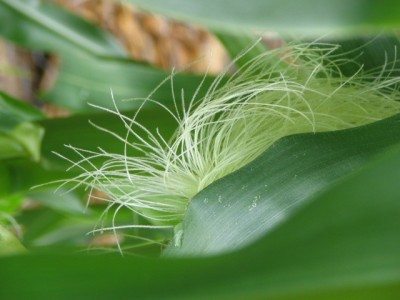We are quickly approaching the time with corn tassels will be emerging and the fruit of our labor will be apparent. In this case, the fruit will be freshly pollinated ears of corn. The appearance of post-pollination ears can tell us a lot about how successful pollination was. There’s more to it than just an ear full of yellow kernels. We can use some of these visual clues to diagnose a problem that may have occurred during a crucial time in the corn plant’s life cycle.
To evaluate pollination success (or failure), you will need to give the plant time to complete the process of pollination. Typically, pollination can take up to 10 days from the time silks emerge. This can be a good time to make some assessments.
First, here is a quick explanation of how pollination works. Corn plants are monoecious, meaning that each plant has both male and female reproductive mechanisms. The tassel is the pollen-producing male structure, and the ear is the female structure which contains the ovules and silks. When pollen comes in contact with a silk, it germinates and creates a pollen tube to the ovule (kernel) and fertilizes it. After this process is completed, the silk will detach from the ovule and turn brown. The completion of this process is what allows us to make an early assessment of pollination success.
Once the majority of the plants in the field have brown silks, pull ears from different areas of the field and carefully remove the husk and shake the ear. Detached silks (that were used to pollinate ovules) will fall away, and any unpollinated silks will remain attached to the ear. An abundance of silks that remain attached indicates some sort of pollination stress, typically drought related or possibly from insect feeding.
Another method for pollination assessment requires waiting a bit longer. Once corn reaches the R2 or blister stage, kernels are mostly formed and will begin to fill. At this stage, one can diagnose the cause of pollination failure. Using the method above of pulling ears from random areas of the field and removing the husks, take a close look for any patterns in the kernels. For example, are there kernels missing from the tip or randomly throughout the ear? Are there rows of kernels missing creating a “zipper” effect?
Ears remaining on plants show pollination failure due to a wide emergence gap early in the season combined with heat stress toward the end of the pollination window. We can arrive at this conclusion because, based on the field history, we know that emergence lasted about 30 days, and the ears surrounding plants failed to pollinate the tips of the ears. Generally, ovules closer to the base of the ear will pollinate first and proceed toward the tip.
Missing kernels throughout the ear indicates drought or heat stress during pollination. Silk production is highly dependent on water availability; during drought conditions, corn plants struggle to produce silks, and, therefore, pollen reception is limited. While pollen is very resilient, temperatures about 100° F are detrimental to pollen viability.
In conclusion, while pollination is mostly out of your control, there are steps you can take to learn from past experiences. Taking time to assess pollination success can help you make management decisions, including future hybrid placement as well as planting date. Also, if the weather forecast is indicating high temperatures or drought, a fungicide application may help reduce stress at this critically-important stage for your corn plants. For more information on ear deformities, visit the agronomy resources tab at beckshybrids.com.
~ Alex Long, CCA – Field Agronomist

